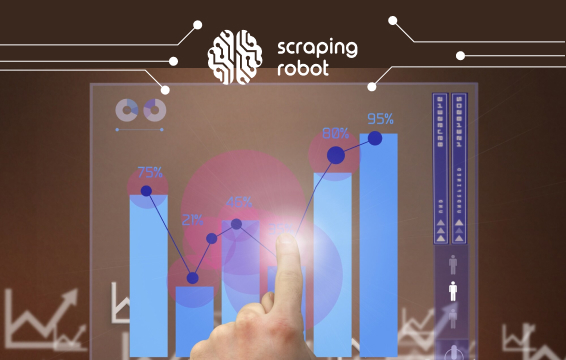Business Intelligence And Analytics: A Data Strategy Guide

Table of Contents
1. The Importance of Business Intelligence and Analytics
2. Breaking Down Business Data: Terms to Know
3. Web Scrapers as Powerful Data Analysis Tools
4. Benefits of Business Intelligence Analytics for Your Business.
As people come to depend more and more on technology to help them navigate their daily lives, so does the data they generate become more valuable as business insights. 10 years ago, barely one-fourth of the world was using social media and you would be hard-pressed to find someone who made life decisions based on what they see on social media.
Now, about 4.2 billion people make use of social media platforms and nobody buys anything until their favorite influencer has posted it. As a business owner, these digital footprints generated by people who have or might have an interest in being your customer are a goldmine of valuable business insights. And with the proper data collection tools and using business intelligence and analytics strategies, you can easily employ these veins of data to fuel your business strategies.
Gathering this information can seem like an enormous task for you as a business owner. Valuable business data is scattered all over the internet and extracting it can be a real headache. However, with the right tools, it doesn’t have to be. Just as the way data is generated has evolved, so have the tools that gather this data. Web scraping is one of those tools. We’ll discuss how web scraping helps businesses collect data and learn things about their consumers, but first, let’s start from the top to cover all of our grounds. If you already know the basics, feel free to skip around to the information most relevant and helpful to you.
The Importance of Business Intelligence and Analytics

A recent Deloitte survey stated that “96% of [the] respondents feel that analytics will become more important to their organization in the next three years.” This is an undeniable indicator of the value which proper business intelligence and analytics offers to businesses across all industries and sectors. Everybody is jumping on the bandwagon.
Data-driven customer strategy
Business is centered around smart decisions, and the decisions made from data analytics have the power to impact almost every department within a company. Data collected can help find customers, improve your customer retention rate, improve customer service experience, drive marketing, advertising, and public relations campaigns, increase social media interaction and followings, and uncover sales trends of your customers and employees. Not only does this data uncover insights for these things, but it solves current problems and improves processes in these departments.
Business intelligence and analytics, however, go beyond just collecting the data. It involves analyzing and contextualizing the data collected to determine just how that data set relates to the current situation of your customer base. It allows you to meet your customers at their points of need using their own data. That is a perfect example of using business data analytics to meet a customer at the point of need. Now, while you might not be at the level of these social media giants, there are still a lot of ways you can employ business intelligence and analytics to help drive your business decisions.
Customer-focused content
Business intelligence and analytics allow you to find out the when, the what, why and how of your relationship with your customers. When do they buy from you? What do they buy? How do they buy it? And why do they buy that particular product? For example, say you get a sudden spike in sales after bringing on a new content manager. Now, you would normally assume that there is a correlation between your new content manager and the increased sales.
But is your content manager the direct cause of the sales? So you might ask questions like, when do the new sales occur? The answer to this question could be “after every new blog post.” So definitely, people are buying more after you put up a new blog post. So what exactly are they buying? Do they buy a diverse range of products or the sales are concentrated on a particular product? The answer to this question will tell you if your blog posts are promoting all your products or just one of them. Then after this, you ask yourself, “why are they buying?” Is it because you have an extremely effective call-to-action? Or your blog posts have become more helpful? Or you are the only one offering that particular solution in your blog posts?
Business intelligence and analytics help you provide answers to all these questions, improve your business to make better decisions and focus on those aspects of your business that are actually driving sales.
Breaking Down Business Data: Terms to Know

As stated by the International Institute of Business Analytics, “Business data analytics is a practice by which a specific set of techniques, competencies, and procedures are applied to perform the continuous exploration, iteration, and investigation of past and current business data, to obtain insights about a business that can lead to improved decision-making.”
In the course of exploring the potentials offered by business data analytics as defined above to your business, you may come across some terms that do not offer themselves to easy understanding. So we’ll define some of them here.
Business analytics vs. data science
The difference between business analytics vs. data science lies in the background education of individuals with these titles. Someone who has studied business data presents more things related to business planning and analyzing trends to develop pricing, marketing plans, etc. On the other hand, data scientists have a more traditional background with studies such as linear algebra, computer science, programming, etc. Data science brings vital insights from a broader perspective of data, while the primary goals of business analysis are to provide solutions to particular problems and growth roadblocks your business may be going through. Business analytics and data science will often be used interchangeably, and the line between them is often grey and crosses over. Some of the components of business analytics are data aggregation, forecasting, visualization, and mining.
Data aggregation
Data aggregation is a broad term describing data presented in a summarized form. This could mean averaging rates over some years to be presented as one number versus displaying five different rates. It could also involve terms like mean, median, etc.
Business data forecasting
Forecasting trends is a more common method we see used in everyday life. We see it a lot in pop culture in magazines as they predict clothing trends as to what sort of clothing garments will sell better than others and many other categories. In a broader sense to business, this is analyzing past trends to try and predict buyer behavior a little bit better or narrow down more characteristics of your buyer demographics, such as age, gender, income range, or other characterization traits.
Data visualization
Data visualization refers to viewing your data in a graphical representation. Images such as pie charts, graphs, maps, etc. are sometimes used to present a more logical way of viewing information than other channels of data viewing.
Data mining
Data mining is a process used to analyze data from any more extensive sets of raw data. This most often helps segment customers into more specified niche groups that businesses will use to help formulate marketing plans, product development, programs, etc. Some data mining technologies can help uncover trends from big chunks of data to help uncover more valuable insights.
Data Scraping
Similar to data mining, data scraping collects valuable data that allows organizations and individuals to identify trends, understand consumer sentiments, improve their brand strategies, and more. We believe that data scraping is one of the best tools for collecting and analyzing business data because it’s reliable, fast, efficient, and affordable.
Web Scrapers as Powerful Data Analysis Tools

Web scrapers (or data scrapers) are a quick and affordable method to begin data mining for business analytics. If you are new to web scraping, it’s a much less complicated and time-consuming process than you think. Essentially, web scraping “bots” are directed to extract publicly available data from websites by reading the web page’s makeup language (usually its HTML). It’s sort of like an elevated version of copy and paste, but much more efficient and scalable. You can direct a web scraping bot to scrape multiple websites or results of a search engine to gather your information by category to be viewed at your convenience.
Going a step further, web scraping can also employ APIs to make your data collection process even smoother. APIs are interfaces that allow unrelated software to communicate. API technology has really exploded in the past few years, with the development of the microservices software ecosystem. With APIs, you can set up a data collection funnel that goes directly from your scraping software into your database or analytics software. Also, if you have an application that makes use of an API but requires data from external sources, you can connect it with a scraping API to get data from any source on the internet. This is better than trying to link your application API to different sources individually.
With web scraping processes, your business data analytics strategy becomes a lot easier to implement as you always have data at your beck and call. With scraping APIs, you can even obtain real-time data that is extremely valuable for trend analysis.
Benefits of Business Intelligence Analytics for Your Business
 Now that we know what business intelligence and analytics are and why you need them, let’s look at a few specific use-cases.
Now that we know what business intelligence and analytics are and why you need them, let’s look at a few specific use-cases.
- Building recruitment strategy: Business intelligence and analytics allow you to use data to predict hiring trends, analyze applicant data across the industry and generally select only the right employees to hire. With proper business intelligence, you can develop a recruitment strategy that spans several years and helps you retain the optimum number of employees at every level of growth for your business.
- Developing better products: Business data analytics also helps you develop better products. By collecting data on products that have been successful in the past and identifying trends that made them successful, you can easily model your own products after these products and even adjust them for future trends with predictive analysis.
- Generate leads: For your marketing needs, business intelligence helps you generate new leads from the multitude of people that show interest in your business. It also allows you to use customer data to identify customers who are ripe for upselling or who are gradually phasing away from your business so you can target them better. To learn more about using web scraping to generate business leads, check out our blog article on the topic.
- Watch your competitors: With data scraped from sites like Amazon, you can keep an eye on the products of the competition and even their marketing tactics. Scraping Robot has several modules for more e-commerce vendors, too, and we can custom-build any scraper for competitor analysis.
- Keep tabs on your products: Elaborating on data science for businesses, you can web scrape sites to stay on top of price intelligence, ensuring that vendors are selling your product for the correct prices, and ensuring that your product performs the best on the market to its ability.
For more ideas, check out this article from our blog.
Data Science for Business With Scraping Robot

Whether you own a business with one employee or several thousand, your time is valuable. We want to give you the tools to successfully scrape your business data and analyze that into results that meet goals and blow your expectations out of the water. With our scraping technology and public API, we can find the data for every need. Data scraping for business analytics and our user-friendly interface allows it to be a painless process for you, even if you’re a beginner. Once you enter the initial request for your scrape, our Scraping Robot bots are out working, and you’re free to come back and download your data into one CSV file when you’re ready to send it off to your analyst or put your analyst hat on or our API can send it on to your database or wherever you want it with no need to download.
We offer 5000 free scrapes per month and depending on the frequency and amount of modules you take advantage of, the price is low, and you can fit into any budget at just $0.0018 per scrape. Our pricing page allows you to plan out your scraping plan at the exact cost without any extra expenses coming up at you.
Conclusion
 Taking hold of the data revolution and using it to your advantage is easier than you think, no matter your business’s size. With business intelligence and analytics, fueled by web scraped data obtained with Scraping Robot.s web scraping service and funneled into your database or analytics software by our public API, you can easily extract those hard-to-reach nuggets of business insights and build a better business.
Taking hold of the data revolution and using it to your advantage is easier than you think, no matter your business’s size. With business intelligence and analytics, fueled by web scraped data obtained with Scraping Robot.s web scraping service and funneled into your database or analytics software by our public API, you can easily extract those hard-to-reach nuggets of business insights and build a better business.
The information contained within this article, including information posted by official staff, guest-submitted material, message board postings, or other third-party material is presented solely for the purposes of education and furtherance of the knowledge of the reader. All trademarks used in this publication are hereby acknowledged as the property of their respective owners.
